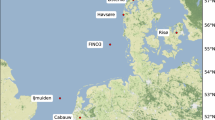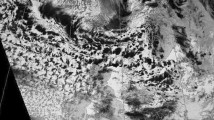Abstract
The profile structure of wind speed and temperature in katabatic flow over a melting glacier is analyzed within the log-linear framework. Similarity between windspeed and temperature profiles is indicated but the log-linear model should be restricted to heights within 1.5 m of the ice. Marked deviation from the model occur at greater heights, probably due to the effects of flux divergence.
Unlike results from other stable atmospheres, a decreases with increasing stability. This may arise from the use of the Obukhov length L. When the height H at which the wind speed reaches its maximum value is used instead, α does not vary with stability. It has mean values of 4.5 and 4.3 for windspeed and temperature profiles, respectively.
Similar content being viewed by others
References
Bradley, E. F.: 1968, A Micrometeorological Study of Velocity Profiles and Surface Drag in the Region Modified by a Change in Surface Roughness, Quart. J. Roy. Meteorol. Soc. 94, 361–379.
Dyer, A. J.: 1974, ‘A Review of Flux-Profile Relationships’, Boundary-Layer Meteorol., 7, 363–372.
Hicks, B. B.: 1976, ‘Wind Profile Relationships from the Wangara Experiment’, Quart. J. Roy. Meteorol. Soc. 102, 535–552.
Holmgren, B.: 1971, Climate and Energy Exchange on a Sub-Polar Ice Cap in Summer. Part C. On the Katabatic Winds Over the North-West Slope of the Ice Cap. Variations of the Surface Roughness, Medd. Meteorol. Inst. Uppsala Univ. 109, 43 pp.
Melgarejo, J. W. and Deardorff, J. W. 1974; ‘Stability Functions for the Boundary Layer Resistance Laws Based upon Observed Boundary Layer Heights’, J. Atmos. Sci. 31, 1324–1333.
Munro, D. S. and Davies, J. A. 1977; ‘An Experimental Study of the Glacier Boundary Layer over Melting Ice’, J. Glac. 18, 89–99.
Sheppard, P. A., Tribble, D. T., and Garratt, J. R. 1972; ‘Studies of Turbulence in the Surface Layer over Water (Lough Neagh). Part I. Instrumentation, Programme, Profiles’, Quart. J. Roy. Meteorol. Soc. 98 627–641.
Webb, E. K.: 1970; ‘Profile relationships: the Log-Linear Range, and Extension to Strong Stability’, Quart. J. Roy. Meteorol. Soc. 96, 67–90.
Weisman, R. N.: 1977, ‘Snowmelt: a Two-Dimensional Turbulent Diffusion Model’, Water Resour. Res. 13, 337–342.
Yu, T.: 1978, ‘Determining Height of the Nocturnal Boundary Layer’, J. Appl. Meteorol. 17, 28–33.
Author information
Authors and Affiliations
Rights and permissions
About this article
Cite this article
Munro, D.S., Davies, J.A. On fitting the log-linear model to wind speed and temperature profiles over a melting glacier. Boundary-Layer Meteorol 15, 423–437 (1978). https://doi.org/10.1007/BF00120604
Received:
Published:
Issue Date:
DOI: https://doi.org/10.1007/BF00120604




